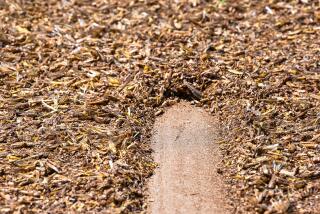One day, catheters could be designed like this beetle’s penis
The penis of the thistle tortoise beetle is longer than its entire body, and yet remarkably good at withstanding breakage during sex — and scientists have discovered why.
The findings, detailed in the journal Science Advances, could aid in the development of safer catheters and other medical devices.
Insect penises are natural wonders. Some of them are extremely thin and very long – sometimes twice the length of the insect’s body. In the case of insects like the male thistle tortoise beetle (known formally as Cassida rubiginosa) it has a curve at the end, in order to contend with the female’s sexual organ: a long spiral structure the male member has to successfully navigate.
“Penetration does not appear to be a very simple task for males,” the study authors noted.
Creating something that is long and thin, but that won’t break, is no easy task. Long, thin tools are stuck between a soft and a hard place: If they’re too flexible, they’ll bend without penetrating anything, and be difficult to wield with accuracy. Too stiff, and they’re liable to break.
Certain insect penises seem to have navigated this dilemma – but there’s been very little research on exactly how they work, the study authors pointed out.
“Breakage of the elongated structures does not often occur,” they wrote. It’s really rare: about 0.8% to 3.4% of males of different earwig species, for example. “How do these animals achieve their challenging task without breaking their thin and seemingly fragile structures?”
To see what secrets the thistle tortoise beetle’s sex organ held, the researchers from Kiel University in Germany put beetle penises through a three-point bending test. They used a universal testing machine to measure the penis’s stiffness in 300-micrometer segments, checking every second segment along its length. The members were so tiny that the scientists had to use a microscope.
The scientists found that the beetle penis was stiffer near the base and more flexible near the tip — and with good reason, they wrote.
“The relatively low bending stiffness of the flagellum’s apical part is advantageous for the flagellum, allowing it to fit into the strongly spiraled spermathecal duct of the female,” the scientists wrote. “On the other hand, the relatively high bending stiffness of the rest of the flagellum enables it to efficiently transfer the penetration force applied to the proximal end of the flagellum.”
So the stiff base ensured the male beetle could penetrate the female, and the softer tip allowed him to move through her spiral organ without breaking along the way.
The inner curve of the male’s penis was also dominated by a more rubber-like protein called resilin, while the outer curve was made of harder stuff. This dual composition would have also helped make the beetle’s member more resilient, the scientists said.
“This material distribution found in the flagellum tip might make it tougher, because it is known that a sclerotized cuticle layer with an unsclerotized cuticle layer added to the tensile surface can store higher elastic strain energy before failure,” the scientists wrote.
The curved tip and cylindrical shape of the tapered penis would have helped too, they added.
Such insights could help researchers design better catheters for use inside the human body, the scientists said – ones that could reduce the risk of associated health complications.
“Considering certain functional similarity between the biological system of the beetle penis and medical catheters in terms of insertions of long and thin ducts into narrow spaces, our results could provide us with some hints for further technical improvement of existing catheters,” the scientists wrote.
The next step is to take the scientific understanding of beetle sex organs to the next level – which may involve capturing them on camera, the authors said.
“Filming of beetle genital movement using synchrotron-based in vivo x-ray cineradiography should be applied as a next step,” the researchers wrote. This and other future work, they added, “will be essential for the further understanding of this fascinating biomechanical system that is highly important not only for evolutionary biology but also for the future development of medical devices.”
Follow @aminawrite on Twitter for more science news and “like” Los Angeles Times Science & Health on Facebook.
MORE IN SCIENCE
NASA’s dangerous Juno mission: Unravel the mysteries of Jupiter and solve the mysteries of life
A hunt for dark matter in a former gold mine
For a 3-year-old boy, a risky operation may mean a chance to hear







